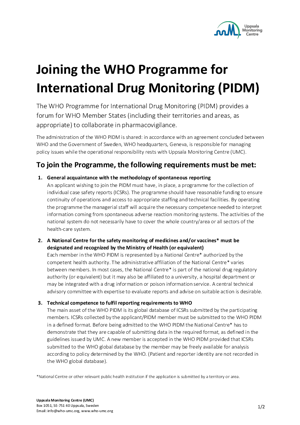Joining the WHO Programme for International Drug Monitoring
The WHO Programme for International Drug Monitoring (WHO PIDM) provides a forum for WHO member states (including their territories and areas, as appropriate) to collaborate in pharmacovigilance.

The administration of the WHO PIDM is shared in accordance with an agreement concluded between WHO and the Swedish government; WHO headquarters in Geneva is responsible for managing policy issues, while the operational responsibility rests with Uppsala Monitoring Centre (UMC).
Procedure
The practical procedure for joining the WHO PIDM is as follows:
- A formal application to be admitted as a member of the WHO PIDM should be sent to WHO headquarters, Geneva, by the competent health authority. The application should identify the institution and responsible person representing the country (or the territory/area) as a national centre* in the WHO PIDM. An applicant will be regarded as an associate member from the time the formal membership application is accepted. Associate members will receive assistance from WHO and UMC in respect of services and tools to enable them to become full members.
- A sample of at least 20 individual case safety reports (ICSRs) should be submitted to VigiBase. Reporting instructions may be obtained from UMC. Please note: this step may be taken simultaneously or even before a formal application is sent to WHO headquarters. The sample reports will be subjected to a check by UMC staff for technical compatibility with the reporting requirements. Any deviation will be reported back to the national centre*. When compatibility of the reports is ensured, WHO headquarters will be notified by UMC. The applicant will subsequently receive a confirmation from WHO headquarters of its admittance to the WHO PIDM as a full member.
Requirements
To join the programme, the following requirements must be met
- General acquaintance with the methodology, and implementation of spontaneous reporting
An applicant wishing to join the WHO PIDM must have, in place, a programme for the collection of ICSRs. The relevant programmes should have reasonable funding to ensure continuity of operations and access to appropriate staffing and technical facilities. By operating the programme the managerial staff will acquire the necessary competence needed to interpret information coming from spontaneous adverse reaction monitoring systems. The activities of the national system do not necessarily have to cover the whole country/area or all sectors of the healthcare system. - A national centre for the safety monitoring of medicines and/or vaccines* must be designated and recognised by the Ministry of Health (or equivalent)
Each member in the WHO PIDM is represented by a national centre* authorised by the competent health authority. The administrative affiliation of the national centre* varies between members. In most cases, the national centre* is part of the national drug regulatory authority (or equivalent) but it may also be affiliated to a university, a hospital department or may be integrated with a drug information or poison information service. A central technical advisory committee with expertise to evaluate reports and advise on suitable action is desirable. - Technical competence to fulfil reporting requirements to WHO
The main asset of the WHO PIDM is its global database of ICSRs submitted by the participating members. ICSRs collected by the applicant/PIDM member must be submitted to VigiBase in a defined format. Before being admitted to the WHO PIDM the national centre* has to demonstrate that it is capable of submitting data in the required format, as defined in the guidelines issued by UMC. A new member is accepted in the WHO PIDM provided that ICSRs submitted to the WHO global database by the member may be freely available for analysis according to policy determined by the WHO. (Patient and reporter identity are not recorded in the WHO global database).
Additional measures to be taken to facilitate collaboration: UMC’s staff need to have access to an up-to-date version of the national drug formulary or equivalent in Latin text, in order to identify drug names mentioned in the ICSRs. Whenever new editions of the formulary are issued, one copy should be made available to UMC. If a suitable national drug formulary or equivalent does not exist, relevant drug information should be submitted according to some other routine agreed with UMC staff. Collaboration between the national centre* and UMC is much improved if personal contacts can be established at an early stage. It would be beneficial if a representative of the national centre could spend some time at UMC or if one of UMC’s staff members was invited to visit the national centre.
* National centre or other relevant public health institution if the application is submitted by a territory or area.
